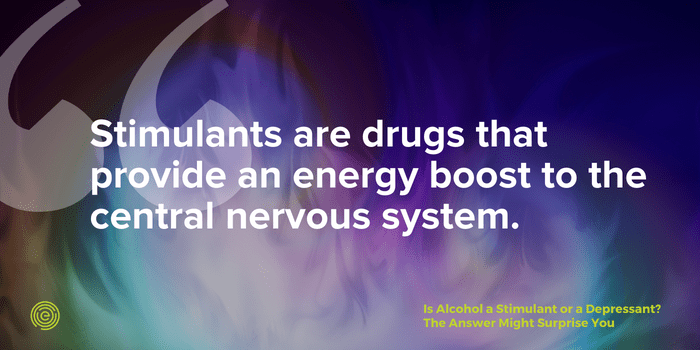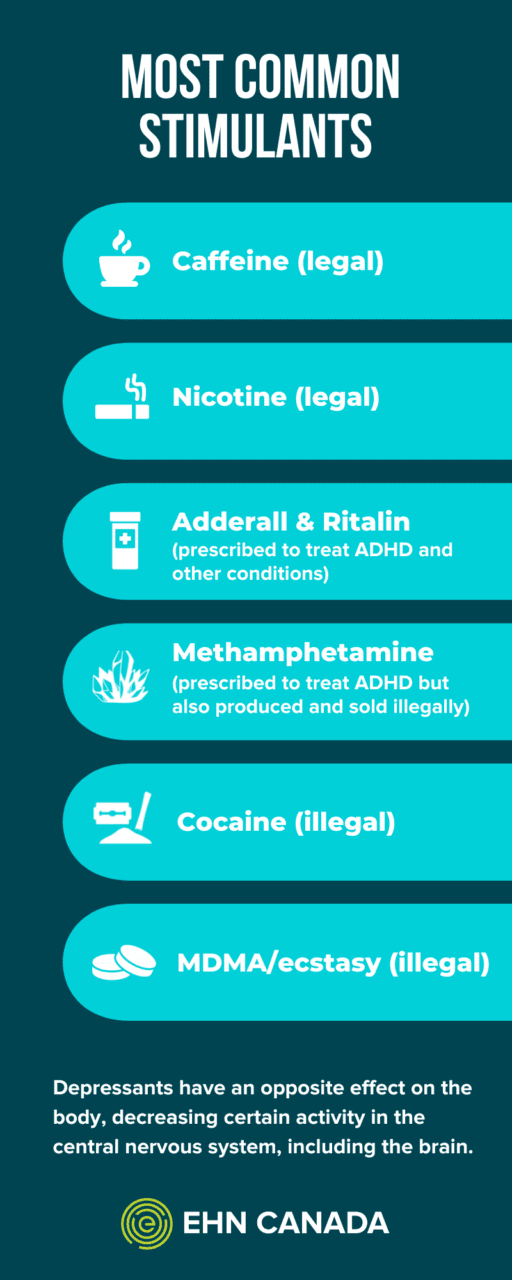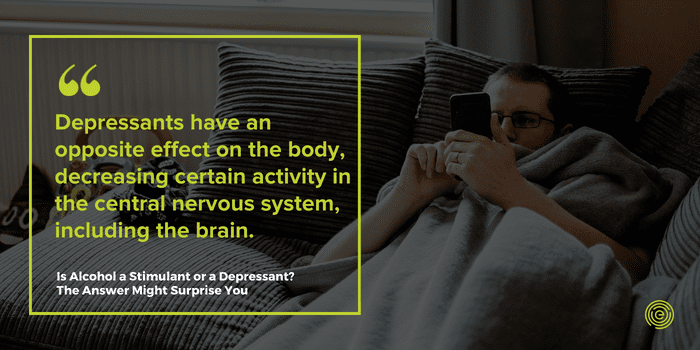What is alcohol and how does it impact your mood?
Alcohol is the intoxicating ingredient in liquor, beer, and wine. It’s a psychoactive substance that can affect physical health as well as mental well-being and stability.
Is alcohol classified as a stimulant or a depressant? The answer is more complicated than it first appears, with no obvious, true or false answer. Alcohol is technically classified as a depressant because it slows, or depresses, basic functions such as speech, reactions, and movement. It also affects brain function and neural activity, impairing the ability to think clearly, altering perceptions of one’s immediate surroundings, and distorting issues of judgment.
However, there’s a good reason why people wonder if alcohol is a stimulant, like marijuana or caffeine. That’s because, when consumed, alcohol has a decidedly antidepressant effect, seeming to act like a stimulant rather than a depressant. Many people, who only drink one or two glasses of wine or beer, may only be experiencing alcohol’s stimulating effects. Once they consume more, however, they experience depressant effects as they lose coordination and start to take foolish actions. The depressant effects of alcohol get far worse when a person overdoses on alcohol, with results that can include vomiting, unconsciousness, and even death.
In many ways, alcohol is both a depressant and a stimulant, much like cocaine and nicotine, which also have this dual effect on the body and mind. They create positive, seemingly uplifting effects initially — but once that stimulant effect wears off, the depression after drinking can be profound, affecting all parts of the body and mind.
The Difference Between Depressants and Stimulants
Stimulants and depressants have very different effects on the body.
Stimulants are drugs that provide an energy boost to the central nervous system. They increase heart rate and breathing rate, they raise blood pressure, they suppress appetite, and they can often cause a rush of euphoria, depending on how they’re consumed.

Some stimulants are highly legal (including that cup of coffee that starts many people’s mornings), while others are available by prescription only and still others are completely illegal to use. The most common stimulants include:
- Caffeine (legal)
- Nicotine (legal)
- Adderall and Ritalin (prescribed to treat ADHD and other conditions)
- Methamphetamine (prescribed to treat ADHD but also produced and sold illegally)
- Cocaine (illegal)
- MDMA/ecstasy (illegal)

Depressants have the opposite effect on the body, decreasing certain activity in the central nervous system, including the brain. Depressants slow the heart rate, gastrointestinal system, and respiratory system. Because of this, they can create feelings of relaxation, drowsiness, and relief from anxiety. However, if the central nervous system and cardiovascular system become overly slowed down through the ingestion of depressants, the lungs and heart’s vital functions can be compromised, possibly resulting in coma or death.

Depressants also range from legal to highly illegal. One particular category of depressants is opioid medications. While these can be very helpful when prescribed for pain management, they are also highly addictive, in part because of the pleasant euphoria they produce. Many people abuse these prescription drugs, even though they’re technically legal to take. The most common depressants include:
- Alcohol (legal)
- Opioids, including morphine, hydrocodone (Vicodin), codeine, oxycodone (OxyContin), and fentanyl (prescribed for pain management but can be abused)
- Barbituates, including amobarbital and phenobarbital (prescribed for seizures and other conditions but can be abused)
- Benzodiazepines, including Valium and Xanax (prescribed for anxiety but can be abused)
- Heroin (illegal)
Alcohol As a Depressant
Alcohol is considered a central nervous system depressant. It slows brain function by affecting the neurotransmitter GABA (gamma-aminobutyric acid). GABA slows brain activity, resulting in slurred speech, relaxation, coordination problems, and drowsiness — and alcohol amplifies the effects of GABA on the brain’s receptors.
The neurological effects of alcohol also include slowness in mental processing. Alcohol hinders the ability to think rationally and it distorts both perception and judgment. It also slows physical and mental reactions to stimuli and lessens personal inhibitions. In essence, the depressant effects of alcohol reduce stimulation to the brain, which is why alcohol and other depressants and tranquilizers are often colloquially known as “downers.” If carried to extremes, alcohol can slow the central nervous system so much that breathing and heart rate are affected.
Alcohol As a Stimulant
While alcohol is technically a depressant, when it’s first ingested, it acts very much like a stimulant. Alcohol triggers the brain to release dopamine, a neurotransmitter that provides energy, stimulation, and good feelings. Dopamine also elevates mood, and it increases the ability to feel pleasure and motivation.
In addition, alcohol has stimulating effects on the rest of the body in low doses. Heart rate and blood pressure increase, as do alertness, confidence, and energy levels. These stimulant effects, though, aren’t the same for everyone. Body chemistry, weight, age, and sex can all affect alcohol metabolism, as can the extent to which a person has built up a tolerance to alcohol.
As the blood alcohol concentration (BAC) approaches 0.05 milligrams per liter, its stimulant effects increase. However, by the time a person reaches a BAC of 0.08 mg/l (the legal level of intoxication in most regions), the depressant effects of alcohol have pushed the stimulant effects aside.
What Is Alcohol, Then?
Alcohol is technically a depressant — but it certainly has a lot of characteristics of a stimulant in the early stages of use. Anyone who has felt themselves getting more confident, more energetic, and less inhibited after a drink or two is well aware of the stimulating effects of alcohol. That’s because of the release of dopamine, which lessens feelings of pain and increases feelings of happiness. Alcohol’s ability to raise the heart rate also tilts it toward the stimulant category — for a while, at least.
However, because those stimulant effects are temporary, it’s important to remember that ultimately alcohol falls on the depressant side of the equation. Think about the feeling of slow reaction times, awkward stumbling around, and slurring words — those are all marks of a depressant.
Because different people respond to alcohol differently, that moment when alcohol ceases to be a stimulant and starts acting like a depressant may vary from one person to another. In addition, some people seem to be especially susceptible to the stimulant effects of alcohol. These people are more likely to experience alcohol addiction.
Example: Is Tequila an Upper or Downer?
A lot of claims are made about tequila. Some people say it’s actually an upper because it makes people who drink it happy. People claim it’s even healthy because the agave it’s made from can help lower triglycerides. People even claim that you can’t get hungover from drinking high-end tequila.
Nevertheless, as a form of alcohol, tequila is still a downer. The alcohol molecules (ethanol, to be technical) that are in tequila are the same as those in whisky, wine, beer, vodka, and other liquors. That means that, despite its initial effects, tequila is still a depressant.
The Chemical Composition of Alcohol
Alcohol, as commonly referred to in the context of beverages, is chemically known as ethanol or ethyl alcohol. Ethanol is a clear liquid produced through the fermentation of sugars by yeast. This fermentation process converts sugars present in fruits, grains, or vegetables into ethanol and carbon dioxide. Different alcoholic beverages contain varying amounts of ethanol, which is influenced by the type of raw material used and the fermentation and distillation processes involved. For instance, beers and wines have a lower ethanol content, resulting from direct fermentation, whereas spirits like whiskey, vodka, and rum have a higher ethanol concentration due to additional distillation steps.
When consumed, ethanol is quickly absorbed into the bloodstream, primarily through the stomach and small intestine. It then exerts its effects on the central nervous system. The liver metabolizes the majority of the ingested ethanol, but it can only handle a limited amount at a time, leading to the accumulation of alcohol in the bloodstream when consumed in excess. This accumulation is what causes intoxication and impairs cognitive and motor functions. Additionally, the presence of other compounds like congeners, which are byproducts of fermentation and aging, can influence the taste, aroma, and even the aftereffects of different alcoholic beverages.
Biphasic Response: Why Alcohol Can Feel Like Both a Stimulant and Depressant
The effects of alcohol on the human body and mind can be described as a biphasic response, meaning it has two distinct phases. Initially, as one starts to consume alcohol, there’s an uplifting, stimulating effect. This is the first phase of the biphasic curve, where the release of dopamine in the brain induces feelings of pleasure, increased sociability, and heightened confidence. Alcohol, at this stage, acts as a stimulant, reducing inhibitions and producing a sense of euphoria.
However, as one continues to drink and the blood alcohol concentration (BAC) rises, the second phase of the response kicks in. The depressant effects of alcohol start to dominate, leading to sedation, impaired judgment, slowed reaction times, and decreased motor coordination. This shift from stimulation to depression is the very essence of the biphasic curve. It’s this dual nature that often confuses people, as the same beverage can make someone feel lively and animated at one moment and then drowsy and lethargic the next, depending on the amount consumed and the individual’s tolerance.
Safety Concerns: Recognizing When Alcohol’s Depressant Effects Go Too Far
Alcohol, when consumed in moderation, can be part of social rituals and gatherings, bringing relaxation and even mild euphoria. However, when alcohol is consumed excessively, its depressant effects can become dangerously pronounced. As the central nervous system slows down, individuals may experience impaired judgment, making them more susceptible to risky behaviors such as driving under the influence or making poor decisions that they might not otherwise consider. Furthermore, excessive alcohol consumption can lead to slowed reflexes, impaired coordination, and drowsiness, increasing the chances of accidents and injuries.
Beyond the immediate risks, excessive and prolonged consumption can lead to alcohol poisoning, a serious and sometimes fatal condition. When the blood alcohol concentration reaches a toxic level, it can suppress vital life-sustaining functions, leading to difficulties in breathing, seizures, hypothermia, and unconsciousness. In severe cases, alcohol overdose can suppress the gag reflex, increasing the risk of choking on one’s own vomit, which can be fatal. Recognizing these dangers and understanding the limits is crucial for anyone choosing to consume alcohol, as it’s always better to err on the side of caution and prioritize safety.
Alcohol and Mental Health: The Fine Line Between Euphoria and Despair
Alcohol’s initial effects on the mind are often characterized by a fleeting sense of euphoria, a light-heartedness that loosens inhibitions and fosters social connections. This mood elevation is attributed to alcohol’s ability to stimulate the release of dopamine, a neurotransmitter associated with pleasure and reward pathways in the brain. For many, this temporary boost in mood can make alcohol seem like a remedy for stress, anxiety, or sadness, offering a brief escape from life’s challenges.
However, this euphoric phase is just one side of the coin. As the effects of alcohol wear off, it can lead to a significant drop in mood, sometimes pushing individuals into feelings of despair, sadness, or heightened anxiety. For those already predisposed to mental health conditions like depression or anxiety disorders, regular alcohol consumption can exacerbate symptoms, leading to a vicious cycle where one drinks to alleviate negative feelings only to have those feelings intensify later on. This delicate balance, teetering between short-lived euphoria and potential mental health exacerbations, underscores the intricate relationship between alcohol and psychological well-being.
Alcohol Addiction
Alcohol addiction can affect anyone, from any walk of life. While genetic factors or psychological factors may predispose someone to addiction, there’s no single cause. Risk factors for alcohol addiction and alcohol use disorder include a history of binge drinking, drinking at a very young age, a history of trauma, and co-occurring mental health conditions, such as personality disorders, depression, or anxiety.
Alcohol addiction is in fact a disease with real physical effects on the brain’s chemistry. It’s considered a mental health disorder because of the lasting physical changes it causes to the brain. Because alcohol is legal and widely available, it can be difficult to recognize the symptoms of alcohol addiction at first. When many people are drinking, it’s hard to single out who might have a significant problem with alcohol. But the symptoms build up over time. Among the symptoms and effects of alcohol addiction are the following:
- Increased intake of alcohol
- Drinking at times considered inappropriate (such as early in the morning)
- Avoidance of old friends in favor of drinking buddies
- Hiding or lying about drinking
- Increased depression or lack of energy
- Spending more time or energy acquiring and drinking alcohol
- Injuries from risky behavior or falls
- Cardiovascular issues, including high blood pressure
- Problems with concentration and memory
- Episodes of binge drinking
- Poor performance at work or school
- Dependence on alcohol for normal functioning
- Poor hygiene
- Hallucinations and irrational thinking
- Frequent hangovers
- Frequent slurred speech and lack of coordination
- Alcohol bottles left around the house
- Liver and pancreas problems
- Increased irritability and aggression
- Increased deceitfulness
- Increased conflicts in personal and work relationships
- Avoiding situations where no alcohol will be served
- Legal problems, including arrest, DUI, or being fired
- Failure to follow through on plans and responsibilities
- Self-isolation
Because alcohol addiction gets worse as it progresses, spotting any warning signs early can help someone with addiction avoid significant problems. The longer someone with alcohol addiction continues without seeking help, the worse the effects and consequences can be. Long-term effects of alcohol addiction can include nerve damage, liver damage, and other negative effects on physical health.
In addition, aggressive or impulsive behaviors can become dangerous, and the ensuing legal problems can deprive someone of their freedom or ability to work. Overdoses of alcohol can result in alcohol poisoning, which can be fatal. Seeking alcohol addiction rehab is critical for anyone who is suffering from alcohol addiction.
Seek Professional Help
Alcohol addiction can be especially hard to deal with for many people since alcohol is so readily available and part of so many social occasions and celebrations. But at EHN Canada, we can help those seeking help with the rough parts, leading to recovery and wholeness.
We offer multiple options to help those dealing with alcohol abuse issues. We will help with intervention and detox, and we offer addiction outpatient treatment as well as online counseling programs to help people carry through with treatment even when they can’t come in. Our substance abuse professionals treat not just alcohol addiction but also the co-occurring mental health conditions that may have triggered or exacerbated alcohol use in the first place.
Our medical professionals carry people through treatment and rehab and into recovery, with all the support needed to thrive and prevent relapses. Family programs help loved ones maintain their progress, and aftercare provides a continuing guide to sobriety. Don’t let alcohol damage your relationships, your health, your reputation, and your well-being. Check out our online program for addiction today, or call 1-416-644-6345 to learn more or get started.



